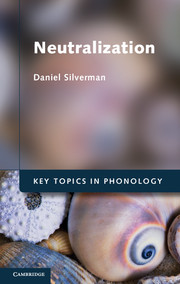Book contents
- Frontmatter
- Contents
- List of Figures
- Preface
- Acknowledgments
- 1 The rhyme and the reason of neutralization
- Part I Rhyme
- Section A Observation and description
- Section B False positives
- 5 Partial phonemic overlap
- 6 Near-neutralization
- Section C Explanation
- Section D Exemplification
- Part II Reason
- Glossary
- References
- Language index
- Subject index
6 - Near-neutralization
Published online by Cambridge University Press: 05 November 2012
- Frontmatter
- Contents
- List of Figures
- Preface
- Acknowledgments
- 1 The rhyme and the reason of neutralization
- Part I Rhyme
- Section A Observation and description
- Section B False positives
- 5 Partial phonemic overlap
- 6 Near-neutralization
- Section C Explanation
- Section D Exemplification
- Part II Reason
- Glossary
- References
- Language index
- Subject index
Summary
Unless we were to admit the possibility of “spelling pronunciations” serving to undo a merger, then values that were phonetically different in the past, but are now identical, cannot become different again. Thus if historic a and historic b merge towards b such that, for instance, historic forms ac and bc both end up bc, the collapse of historic a and b cannot be undone (“unmerged”) at a later point in time; bc will indeed be subject to further changes, but will never split such that the historic a–b contrast is re-introduced as a–b, or as any other phonetic values, say, e–f, along the same lexical lines as their historical antecedents. This fact of sound change goes by the name of Garde's Principle (after Garde 1961): “A merger realized in one language and unknown in another is always the result of an innovation in the language where it exists. Innovations can create mergers, but cannot reverse them. If two words have become identical through a phonetic change, they can never be differentiated by phonetic means” (translated from the French by Labov 1994:311).
In this chapter we consider some putative cases of so-called “unmergings” in light of documented cases of “near-merger”, and “near (or incomplete) neutralization”. Apparent counter-examples to Garde's Principle are, in fact, only that: apparent. The values that were assumed to be merged in the past, or neutralized in the present, can be shown to be (or argued to have been) merely nearly-merged or nearly-neutralized. Near-mergers and near-neutralizations thus cannot be classified as neutralization.
- Type
- Chapter
- Information
- Neutralization , pp. 62 - 77Publisher: Cambridge University PressPrint publication year: 2012



